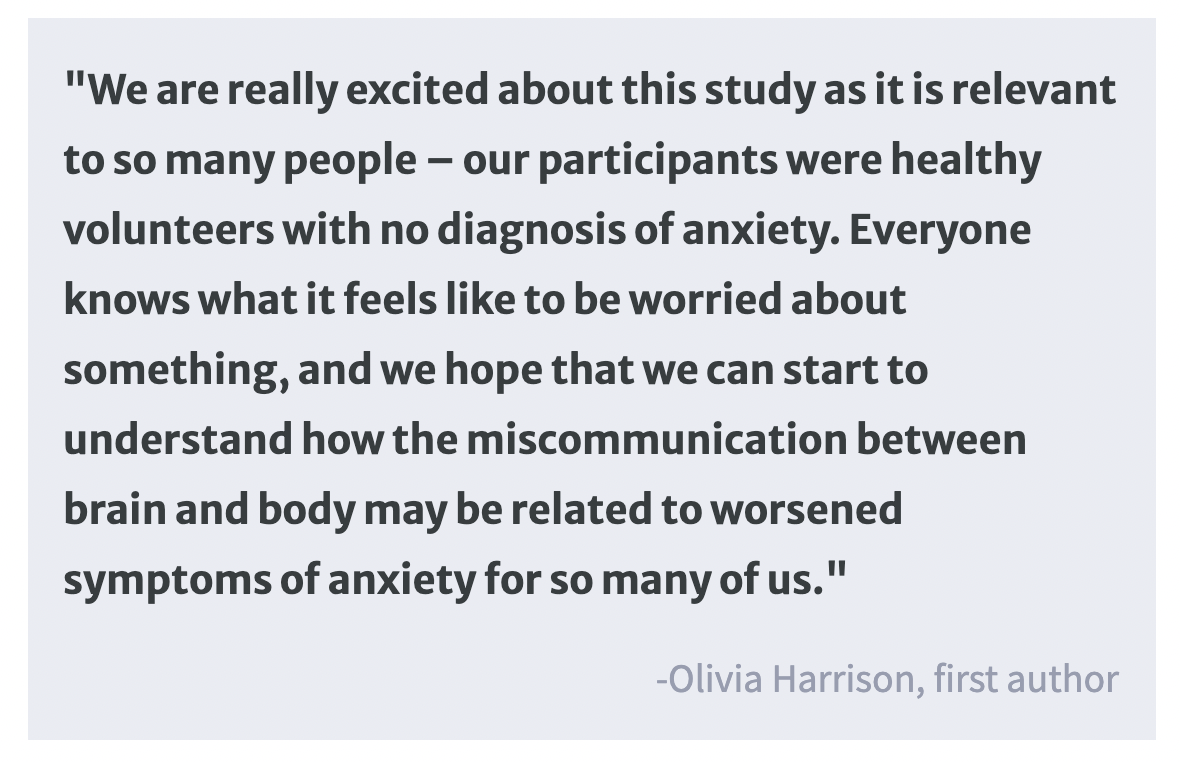The Relationship Between Anxiety and Breathing Perception
Post by Leanna Kalinowski
The takeaway
Many psychiatric disorders are thought to be associated with an impairment in interoception, which is the perception of your body’s internal physiological signals. Sensitivity towards and insight into breathing perception are altered in individuals with anxiety.
What's the science?
Interoception, the brain’s perception of sensations within the body, is an important component of maintaining bodily homeostasis. For example, these perceptions tell you if you’re hungry, if your heart is beating too fast, or if you are experiencing shortness of breath. An impaired ability to monitor your body’s signals is believed to exist in a variety of psychiatric disorders. This is particularly seen with anxiety, where individuals may misinterpret their changes in breathing patterns when feeling worried.
Previous studies on interoception treated it as a single entity, while recent studies identified that interoception spans multiple levels of perception. Notably, “lower” levels of interoception include sensory and psychophysical properties, while “higher” levels of interoception include one’s attention towards bodily signals and accuracy of interoceptive beliefs (i.e., metacognition). However, it is not yet known whether anxiety is differentially related to these levels of interoception. This week in Neuron, Harrison and colleagues evaluated the relationship between anxiety and each level of breathing-related interoceptive processing using self-report measures and two interoceptive breathing tasks.
How did they do it?
The researchers recruited thirty participants to first complete an anxiety questionnaire, after which they were separated into one of two groups: “low anxiety” and “moderate anxiety”. Then, participants were asked to complete three tasks. The first task was a set of questionnaires to assess participants’ subjective measures of anxiety and body awareness. The second task, called the filter detection task (FDT), was then used to measure breathing perception and metacognition. The FDT began with the participants taking three normal breaths on a breathing circuit. Then, one of two filters was applied to the circuit: one filter added resistance, and the other filter did not. Participants took three additional breaths with the filter, and then were asked (1) whether resistance was added and (2) how confident they were in their answer on a scale of 1 to 10.
The final task, called the breathing learning task (BLT), was used to measure brain activity during trial-by-trial interoceptive learning. During each trial, participants were shown one of two visual cues that were paired with either an 80% or 20% chance of breathing resistance being applied. Then, they were asked to predict whether it will be difficult to breathe, after which either a strong resistance or no resistance was applied using a breathing circuit. They were then asked to rate how difficult it was to breathe and subsequently repeated the entire task for a total of 80 trials. Brain activity was measured during all trials with functional magnetic resonance imaging (fMRI).
What did they find?
First, the researchers found that individuals with moderate anxiety showed greater self-reported overall body awareness compared to those with low anxiety. However, participants with moderate anxiety also showed reduced perceptual sensitivity to breathing resistance during the FDT and had lower confidence in their ability to detect breathing resistance, in contrast to the self-reported measures. These results demonstrate multiple different associations between breathing perception and anxiety.
Using the BLT, the researchers then found a relationship between anterior insula activity and both prediction certainty and magnitude of prediction errors on the BLT, suggesting that the anterior insula plays an important role in representing bodily perceptions and updating them as additional trials are completed. Participants with low versus moderate anxiety traits also showed differences in anterior insula activity with prediction certainty. Multi-modal analysis of data from all tasks showed that anxiety is associated with multiple levels of interoception, though stronger effects are seen at higher levels of the interoceptive process (i.e., aspects of metacognition). These results demonstrate that the association between breathing perception and anxiety persists across all levels of interoception.
What's the impact?
This study was the first to show brain activity associated with trial-by-trial interoceptive learning. These results provide new insights into how anxiety is related to breathing perception and implicate the anterior insula in representing and updating perceptions of breathing states. Future research is needed to determine whether these results translate to other interoceptive processes, such as cardiac or gastric states.


